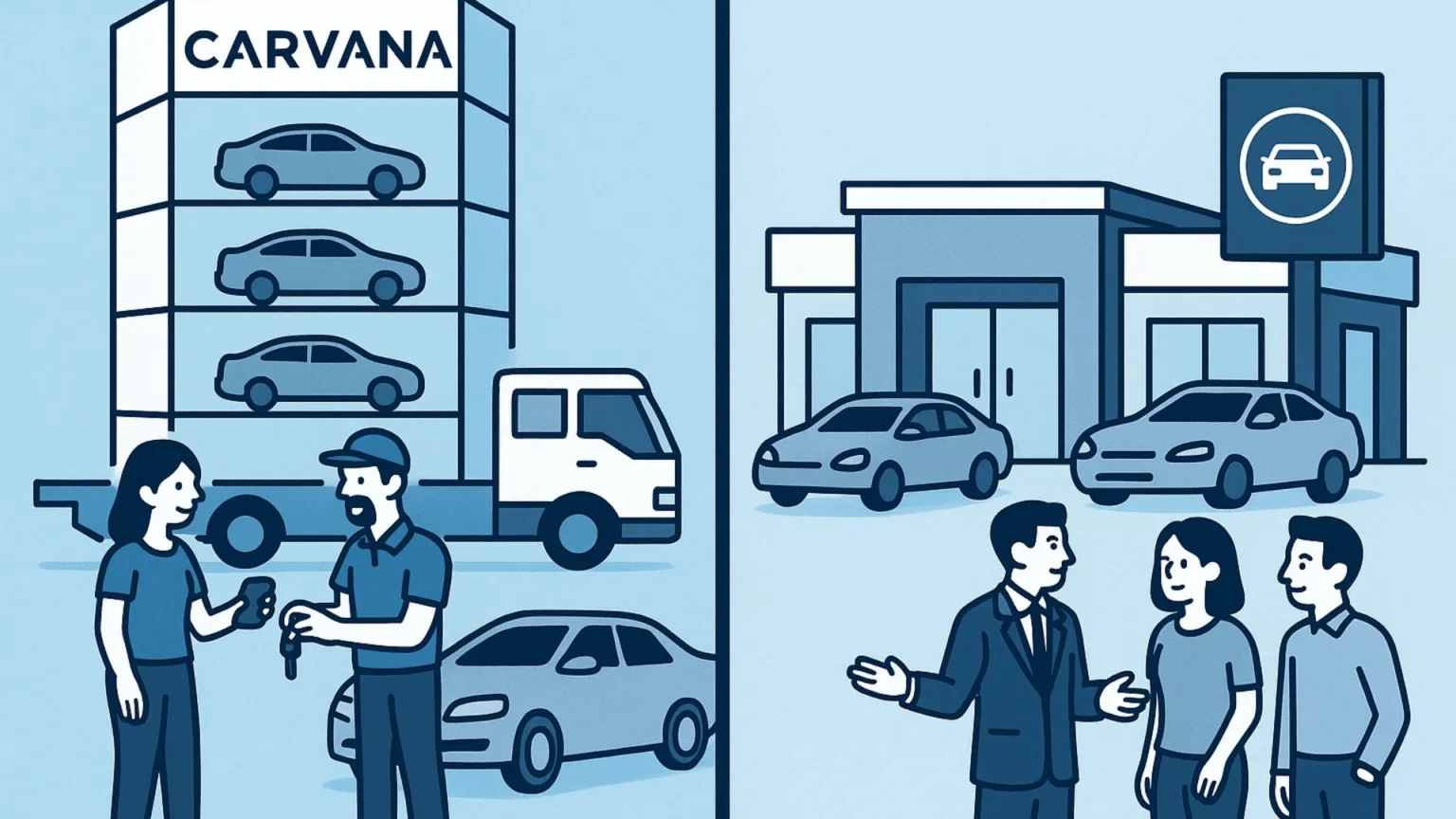
Carvana vs Traditional Dealership: Pros, Cons, and Tips
Table of Contents
Carvana vs Traditional Dealership: Pros, Cons, and Tips
In the rapidly evolving world of automotive sales, the classic method of buying a car is undergoing a digital revolution. Innovative online platforms such as Carvana are challenging the status quo and redefining how we approach car ownership. For automotive professionals and savvy car buyers alike, understanding the nuances between online car buying and the traditional dealership experience has never been more crucial.
In this comprehensive guide, we’ll explore the key differences, the real-world advantages and drawbacks of purchasing vehicles through Carvana versus traditional dealerships, and share actionable tips for both buyers and industry experts. We’ll also draw on industry-leading insights from the Car Studio AI blog, including trends in visual merchandising, centralized listing strategies, and the future of automotive marketplaces.
The Transformation of Car Buying
The car buying journey has changed dramatically with the rise of platforms like Carvana. Buy car online is no longer a futuristic slogan—it’s everyday reality. Carvana offers a seamless, entirely digital purchasing experience, empowering consumers to buy, sell, or finance their vehicles from the comfort of their homes. This model appeals to tech-savvy shoppers who value speed and convenience.
On the other hand, traditional dealerships continue to provide a tangible, hands-on experience. Here, buyers can physically inspect vehicles, take test drives, and negotiate directly with sales professionals. This personal touch remains a significant factor for many, especially those who want assurance and confidence before making a large purchase.
If you want to dive deeper into the evolution of digital retailing, don’t miss Car Studio AI’s article on 6 Visual Techniques Used by Top-Selling Dealers, which highlights how both Carvana and traditional dealers are leveraging technology to boost engagement and trust.
Revolutionizing Car Buying
The Pros of Carvana

The Cons of Carvana
For more on how digital platforms like Carvana compare to other modern marketplaces, check out The Pros and Cons of Different Car Marketplaces for 2025.
Tips for Buying from Carvana
Traditional Dealerships: The Personal Touch
The Pros of Traditional Dealerships
The Cons of Traditional Dealerships
If you’re curious about how dealer groups are scaling their listings and standardizing the in-person experience, How Dealership Groups Use Centralized Merchandising to Scale Listings is a must-read.
Tips for Buying from Traditional Dealerships
Carvana vs Traditional Dealership: Comparing the Experience
When choosing between Carvana vs dealer, consider your priorities. If you want convenience, transparency, and the ability to buy car online without pressure, Carvana is a top contender. If you value the tactile experience of inspecting cars in person, test driving, and negotiating, then the traditional dealership experience might be right for you.

It’s also worth noting how both models are evolving. Many traditional dealerships are now offering digital retailing tools, virtual showrooms, and centralized inventory systems, blurring the line between the two. To get a sense of how hybrid approaches are shaping the future, Carvana vs Private Sale: Which Is the Best Option for Selling Your Car? offers excellent insight into both sides of the marketplace.
Conclusion
Both Carvana and traditional dealerships have unique advantages and drawbacks. As the automotive market continues to transform, industry professionals and car buyers alike must stay informed and adaptable. Whether you’re drawn to the digital convenience of Carvana or the classic charm of a local dealer, the most important thing is to prioritize customer needs, stay educated, and embrace new trends.
Personally, my approach to car buying has evolved with these new options. A few years ago, I wouldn’t have dreamed of buying a car online. But after exploring both Carvana and local dealerships, I realized each has unique strengths. The ability to handle everything online with Carvana is incredibly convenient, but I still appreciate the confidence that comes from a hands-on test drive at a traditional dealer. In the end, I’ve started to blend both approaches—using online platforms for research and price comparisons, then visiting a dealership for that final, tactile experience.
For more insights, tips, and data-driven strategies to optimize your dealership or navigate online auto buying, visit Car Studio AI and explore the latest articles on visual techniques, centralized merchandising, and more.
FAQ Section
What is the return policy for Carvana?
Carvana stands out in the online car buying space thanks to its generous 7-day return policy. After your Carvana purchase, you can drive the vehicle for a full week—whether to work, around town, or even on a short road trip. If for any reason you’re not satisfied, you can return the car within those 7 days for a full refund, no questions asked. This policy offers peace of mind, especially compared to traditional dealership experiences where returns are rare or come with strict limitations. It essentially acts as a “test drive” period, ensuring the vehicle meets your expectations and needs.
Can I trade in my car at a traditional dealership?
Absolutely. Traditional dealerships almost always accept trade-ins, and many buyers use their current vehicle as a down payment towards their next car. Beyond convenience, trade-ins can also become a powerful negotiation tool—sometimes helping you secure a better dealer price or extra incentives. However, it’s wise to get multiple quotes (including instant offers from platforms like Carvana or other online auto buying services) to ensure you’re getting the best value for your used car. Remember, dealers may offer less than private sale prices, but they save you time and hassle.
How does financing work with Carvana?
Financing your next vehicle with Carvana is streamlined and digital-first. Carvana offers in-house carvana financing directly through its platform, allowing you to get pre-approved online in minutes without impacting your credit score. You can easily review loan terms, monthly payments, and interest rates, then select the best option before completing your purchase. Carvana is also transparent about rates and does not use high-pressure sales tactics often found in dealership finance offices. For the best deal, compare Carvana’s rates with your local bank or credit union as well.
Are there hidden fees with dealership purchases?
One of the most common concerns with buying a car from a dealership is the presence of hidden or unexpected fees. Dealerships typically charge for documentation, administration, registration, and sometimes delivery—costs that can add up fast. Some dealers may also include extra fees for services like vehicle prep or even advertising. Always request a complete breakdown of all charges before you sign any paperwork, and don’t hesitate to ask questions. This transparency is one reason why many buyers are attracted to Carvana’s no-haggle pricing and clear fee structure.
How reliable are the vehicle condition reports from Carvana?
Carvana’s approach to used car buying relies heavily on transparency. Every vehicle undergoes a detailed 150-point inspection, and you’ll find comprehensive condition reports—complete with high-resolution photos and noted imperfections—on each listing. While no process is perfect, Carvana’s digital-first approach allows buyers to carefully review vehicle history, features, and condition before making a decision. If you’re concerned about missing the “in-person feel,” remember you can use the 7-day return policy to thoroughly test and inspect the car after delivery.
If you have more questions about carvana experience, dealership pros and cons, or how to optimize your next car buying journey, check out our deep dives on visual merchandising, centralized inventory management, and marketplace comparisons for 2025.
